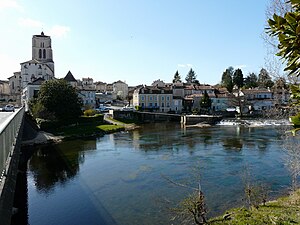Saint-Astier (Dordogne)
|
Saint-Astier Sench Astier |
||
|---|---|---|

|
|
|
| region | Nouvelle-Aquitaine | |
| Department | Dordogne | |
| Arrondissement | Périgueux | |
| Canton | Saint-Astier (main town) | |
| Community association | Isle Vern Salembre en Périgord | |
| Coordinates | 45 ° 9 ′ N , 0 ° 32 ′ E | |
| height | 58–222 m | |
| surface | 34.25 km 2 | |
| Residents | 5,492 (January 1, 2017) | |
| Population density | 160 inhabitants / km 2 | |
| Post Code | 24110 | |
| INSEE code | 24372 | |
| Website | Saint-Astier | |
 Saint-Astier - town view with river Isle |
||
Saint-Astier ( Occitan Sench Astier ) is a small town and a French municipality with 5492 inhabitants (as of January 1 2017) in the department of Dordogne in the region Nouvelle-Aquitaine . The community consists of the main town as well as some hamlets (hameaux) and individual farms (fermes) .
Location and climate
The town of Saint-Astier is located on the west bank of the Isle in the cultural landscape of the Périgord at an altitude of about 75 m . The city of Périgueux is about 20 km (driving distance) to the north-west; the small town of Ribérac is located approx. 25 km south-east. The A89 autoroute runs through the municipality from Bordeaux to Brive-la-Gaillarde . The climate is temperate; Rain (approx. 860 mm / year) falls over the year.
Population development
| year | 1800 | 1851 | 1901 | 1954 | 1999 | 2015 |
| Residents | 1,985 | 2,826 | 2,942 | 3,933 | 5,098 | 5,530 |
The sustained population growth of the small town is to a large extent due to immigration from the rural areas in the area as a result of the increasing mechanization of agriculture and the abandonment of small farms.
economy
Residents of the community lived for centuries as self by the Agriculture and Forestry (cereals, charcoal); Fruit and vegetables were grown in the hotel's own gardens or offered at the market. The lime-rich subsoil has formed the basis for a nationwide important building material industry ( building lime , stucco and gypsum ) since the 19th century . The city has several health and educational institutions.
history
The proven history of the area goes back to the Stone Age . But Gallo-Roman finds were also made; the name of the city goes back to a hermit of the 6th century who was venerated as a saint, named Asterius . In 849 the place was invaded by the Normans . The first known churches in the town were built in the 10th and 11th centuries. In 1219 the place was fortified.
Attractions
- Saint-Astier church, built in the 11th century, rebuilt in the 15th century, monument historique since 1910
- Forest chapel (Chapelle des Bois) from the 17th century, rebuilt in the 19th century, Monument historique since 2007
- Château de Bruneval
- Manoir de Brouillaud , Monument historique since 1979
- 19th century Château de Crognac
- Manoir d'Excideuil
- Repaire de Fareyrou or Chartreuse de Fareyrou , built in the 16th century, monument historique since 2008
- Manoir des Ferrières
- 15th century Château de la Batud
- Manoir de Petit-Puy
- Château de Puyferrat , monument historique since 1862
- Château du Puy-Saint-Astier from the 15th century, rebuilt in the 17th / 18th century. Century, Monument historique since 1988; with pigeon tower
Partnerships
- A partnership with the Laotian community of Kengkok has been maintained through the Collège de Saint-Astier since 1969 .
- A parish partnership has existed with the Italian municipality of Annone Veneto since 2017.
Personalities
- Jacqueline Robin (1917-2007), pianist
- Norbert Aujoulat (1946–2011), prehistoric
Web links
Individual evidence
- ↑ Saint-Astier - Map with altitude information
- ↑ Saint-Astier - Climate tables
- ↑ Saint-Astier - History and Economy
- ↑ Saint-Astier - Église in the Base Mérimée of the French Ministry of Culture (French)
- ↑ Saint-Astier - Chapelle des Bois in the Base Mérimée of the French Ministry of Culture (French)
- ↑ Saint-Astier - Château du Puy-Saint-Astier in the Base Mérimée of the French Ministry of Culture (French)
- ↑ Saint-Astier - Chartreuse de Fareyrou in the Base Mérimée of the French Ministry of Culture (French)
- ↑ Saint-Astier - Château de Puyferrat in the Base Mérimée of the French Ministry of Culture (French)
- ↑ Saint-Astier - Château du Puy-Saint-Astier in the Base Mérimée of the French Ministry of Culture (French)







